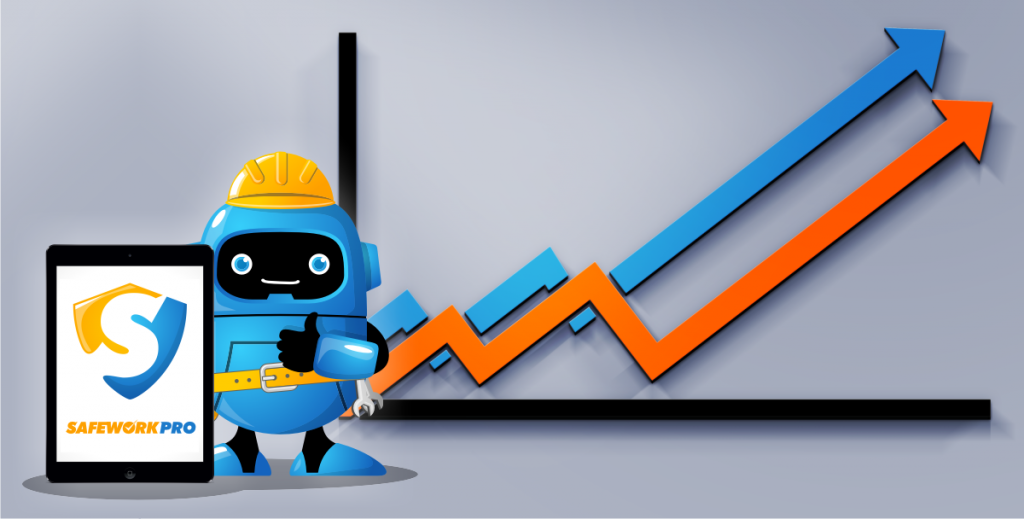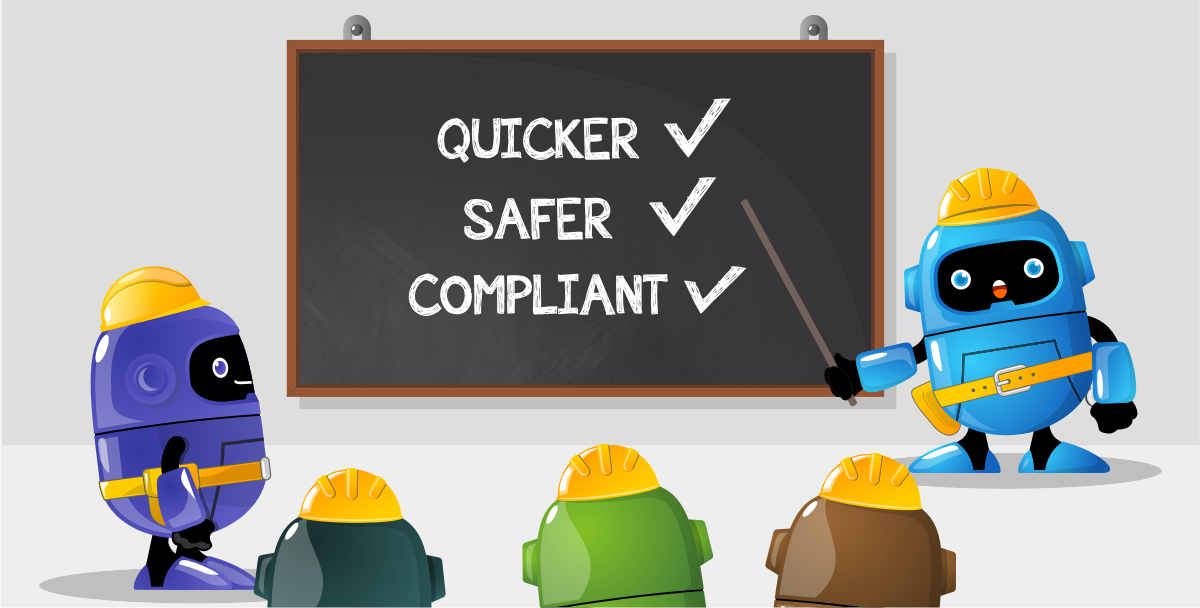3 Signs Safety Software Might Be The Solution For You
Safety software is a relatively new solution to an old problem. Have you ever thought to yourself, there has got to be a better way to stay complaint with safety regulations? Do you ever get frustrated that you have to fill out so many assessments and statements on paper. Do you find yourself missing things in your assessments because you are worried that it’s not in the right format?
These are just some of the frustrations that come with the process of staying compliant with safety regulations. It can have significant effects on your safety culture if you find the process of safety too difficult. If you have ever ran into any of the above, it might be time to consider finding a solution before it becomes too much of a headache that safety goes out the window and all your effort is spent just to be compliant.
In this article we will cover in depth 3 signs that it might be time to consider utilizing safety software before your safety is ignored for compliance.
You’re worried about compliance incase of an incident
Running a business is no easy task. It’s like juggling 10 things at once. When things are going well, it’s a great feeling. But it only takes one slip up or incident to cause everything to come crumbling down. The stress and anxiety of a WHS incident happening in your business is enough to keep anyone up at night. On top of that, if you know you might get slapped with a fine after the incident you’ll always be stressed or worse, you’ll delay reporting an incident. This can lead to huge fines and even jail time. No one wants that.
Safety compliance in the modern day is no simple task. There are a lot of regulations and legislation that you must adhere to in your day to day business. This can become quite a headache and adds to the stress of making sure you have ticked all the boxes. Or worse, leads you to ignoring your requirements and hoping that an incident doesn’t occur. As we have covered in a previous article, incidents happen to even the best of employers who are proactive with safety, its simply the reality of probability. If there is a chance, eventually it will happen.
Ask yourself this. If there was an incident at your workplace tomorrow and it lead to an inspection, would you be confident you would pass? Have you got a solid and refined risk assessment process in place to identify, assess and control risks in your workplace?
If the answer is not a confident yes then it might be time to look at solutions. Safety software like our platform SafeWorkPro allows you to focus on your process more while making the document compliance side of things a worry of the past. While SafeWorkPro won’t solve all of your safety worries, it will help you be more effective with your time so you can spend less time filling out forms and more time focusing on the actions that lead to a safer workplace. We have talked about how your process is more important than your documents in a previous article. In the eyes of the law, the concern is about what you actually do to keep people safe.
If you want to spend more time on safety and less time on the books, then safety software might be the solution for you.
Safety software makes documentation simple and easy
How long does it take you to complete a risk assessment from start to finish? What about a SWMS? Do you find it difficult to complete documents because of all the back and forth that is required between the site, office and in between your workers? If your documentation process is top notch and you have no issues with filling out lengthy paper documents then this might not apply to you. But for those that get frustrated with how much time away from work they have to take to complete documents, this one might be for you.
When the bottle neck for starting a job is the paperwork you need to complete for safety compliance it can become frustrating. It can sometimes feel like too much time is being wasted on paperwork when you could be working. This can lead to rushing through it which defeats its purpose. It also means that you are more likely to skip the processes that really matter to keep people safe.
If you are on a site that needs a SWMS and something changes that requires you to re-evaluate your SWMS, the process starts again and the tools are down until it is done. With safety software, the process of completing documentation is significantly easier. In principle, it is the same but in practice you’re saving time that would otherwise be spent filling a document and running around to get it signed. SafeWorkPro’s simple form based builder allows you to build custom documents which are super simple for your workers to complete on site when needed.
Save the hassle of the back and forth trying to get your documents read and signed by those on site. Have workers fill and sign documents from anywhere on site and have them submitted to the cloud for you to review from any location. SafeWorkPro even lets you get notifications when certain actions happen like a risk rating on a risk assessment matrix being too high or an incident is submitted. SafeWorkPro can help you save time on compliance and let’s you focus on what you do best.
Safety software helps you find old documents quick
Ask yourself this, can you find your risk assessment or SWMS from a job 2 years ago? If you were audited, could you produce it? This is something that isn’t obvious until it is an issue and by then it’s too late. How much of an impact on your day to day operations would a surprise audit have? Would you need to go digging through the back office folders to find the documents required? What a headache!
Even while you are on site, your documents like a SWMS need to be available for everyone to see. While they are there, they are likely to get damaged or degraded by weather. Sometimes, by the time they get stored for safe keeping they are almost falling apart.
With the safety of cloud document storage, SafeWorkPro can store all of your important documents online forever. With all of your documents in one place and neatly organized it’s super simple to find the documents you need, even if they are from years ago. Our software also makes audits quick and easy with next to no disruption in your operations. Export all of the data from your SafeWorkPro site for review without having to spend hours digging through folders, photocopying and physically delivering documents.
Conclusion
If any part of this article resonates with you, it might be time to consider trying out a better solution to using a manual safety process. Beyond just the convenience, SafeWorkPro can help you focus your time on the actions that truly make people safe, not just the actions that make you compliant. At the end of the day, that is what you will be judged on if you have an audit or investigation. Documentation is required of course, but that is simple the surface level when it comes to safety.
If you want to learn more about how SafeWorkPro could help you in simplifying your WHS, reach out to our friendly expert staff for a free, no obligation live demo.
Free Risk Assessment Software: what’s the catch?
In the risk management process, you get what you pay for and although the idea of free risk assessment software seems attractive, you should consider a few factors before signing up. Quality risk assessment software should make the risk management process easier, not add another bureaucratic layer. Luckily for you, we know just the type.

Completing a construction risk assessment form to the standards of Safe Work Australia can be achieved quickly through automated risk assessment tools like SafeWorkPro. Risk identification, safe work method statements and risk assessment matrices are all streamlined into one simple tool available on any smart phone or tablet device. As the dangers of high risk construction work change so too do risk assessments in the workplace. But whereas generic risk assessment forms fail to adapt to these changes, risk assessment software was designed specifically to do just that. This in turn will mean less time is spent searching for the proper paperwork and more time spent getting the job done.
At SafeWorkPro we’ve consulted directly with contractors and calculated just how much time risk assessment software can save you. To back up our claim, we’re offering a trial risk assessment software free download period. You can try our construction safety software without any commitment, and experience first hand just how beneficial it is for your workflow. SafeWorkPro’s construction safety software is an investment that will save you time in the risk assessment process and improve safety standards.
How Can a Quality Assessment Review Maintain Safety?
In successful hazard and risk management it is important to keep on top of changes to OHS laws and regulations as well as how strongly your own risk assessment policy is performing. Although there is not much the ordinary business owner can do about government OHS legislation Australia, there is a great deal that can be done to improve risk assessment procedures.
Conducting a regular and in depth risk assessment review can improve safety and eliminate unproductive work practices. It is also a way to answer some of those basic risk assessment questions.

Under requirements outlined in the Work Health and Safety Regulations, a person conducting a business or an undertaking (PCBU) must review risk control measures and revise where necessary. Such a review must take place when:
- a health and safety representative requests a quality assessment review
- consultative arrangements suggest a review is needed
- a new risk or a different hazard is identified
- upcoming workplace changes are likely to present new risks and hazards that current safety measures may not control
- a safety measure fails to effectively control a risk
To identify these potential issues, a consultation process that involves workers, OHS representatives and managers should consider:
- if the control measures are effective both on paper and in practice
- whether the controls measures have inadvertently produced any new risks
- if all hazards were identified
- whether new work practices, equipment or materials/substances produced any new or different risks
- how useful and successful risk assessment training has been for workers
- how directly involved workers are in risk identification
- what effect changes to OHS legislation or laws could have current safe operating procedures
- if the rate and extent of workplace health and safety incidents is decreasing
Any risk assessment review that takes place should be prioritised based on the seriousness and immediacy of the risk. If a hazard is more serious than the control measures used to reduce its associated risk should be review more often. Don’t wait until something goes wrong; begin a review today!
What is Risk and Reasonably Practicable?

The Work Health and Safety Act 2011 requires that duty holders create and maintain an effective safety culture at workplace through active consultation with relevant stakeholders (eg workers, clients, managers), the provision of health and safety information and through other forms of hazard analysis. Specifically the Act requires that all safety risks are either eliminated or minimised as much as is reasonably practicable.
How to define what is reasonably practicable?
A risk assessment is part of determining what is reasonably practicable. The duty holder, usually the person conducting a business or undertaking (PCBU) or the safety manager, must identify the relevant factors that contribute to the risk analysis process. In other words the PCBU must find a balance between what can be done to eliminate or reduce risks, and what is reasonable to do. The control measures used will be different for many worksites but six considerations must be made.
1: What is the likelihood of a risk occurring?
- The more likely it is that a risk eventuates; the more may need to be done to eliminate or reduce it.
2: How much harm may result if a risk were to eventuate?
- The larger the extent of harm; the more importance will be placed on effective control measures.
3: What is known, or should be reasonably known, about the risk and hazard involved?
- Commonly referred to as the state of knowledge, this is what the duty holder knows about a risk and what he/she should reasonably know about a risk. When determining what should be reasonably known about a risk, a duty holder should consult with workers and other stakeholders, complete a risk assessment, investigate previous risk assessments, and review relevant OHS laws and regulations.
4: What is known, or should be reasonably known about the available control measures to be implemented?
- Safe Work Australia’s codes of practice outline possible control measures but duty holders are not required by law to follow them. However OHS laws do require that duty holders make themselves aware of the codes of practice to ensure they understand the full scope of what is reasonably practicable in the elimination or reduction of risk.

5: What is the suitability and availability of control measures to eliminate or reduce risk?
- To ensure a safe workplace whilst maintaining an organisation’s economic competitiveness, the available control measures as well as the practicable ones should be considered. A risk control that is appropriate for one situation or business, may not be practicable for another.
6: What is the cost of eliminating or minimising risks?
- This point should be considered after all other health and safety options have been checked. The cost of implementing a risk control measure is a definite factor in determining what is reasonably practicable. This is because an organisation’s resources may be limited to a certain extent however it should be noted that the WHS Act clearly favours the prioritisation of safety ahead of cost.
In terms of the full scope and size of the WHS Act, this is but a glimpse of the recommendations on determining what is reasonably practicable. Nonetheless, there are valuable points that any business can apply to their safe operating procedures. For more information on the term reasonably practicable you can read Safe Work Australia’s interpretive guidelines.





